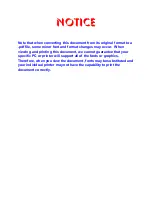
82
83
Pacemakers
Pacemaker manufacturers recommend that a minimum separation of 15 cm be
maintained between a mobile phone and a pacemaker to avoid potential interference
with the pacemaker. To achieve this, use the phone on the opposite ear to your
pacemaker and do not carry it in a breast pocket.
Hearing Aids
People with hearing aids or other cochlear implants may experience interfering noises
when using wireless devices or when one is nearby. The level of interference will depend
on the type of hearing device and the distance from the interference source. Increasing
the separation between them may reduce the interference. You may also consult your
hearing aid manufacturer to discuss alternatives.
Medical Devices
Please consult your doctor and the device manufacturers to determine if the operation of
your phone may interfere with the operation of your medical devices.
Hospitals
Turn off your wireless device when requested to do so in hospitals, clinics, or healthcare
facilities. These requests are designed to prevent possible interference with sensitive
medical equipment.
Aircraft
Turn off your wireless device whenever you are instructed to do so by airport or airline
staff. Consult the airline staff about the use of wireless devices onboard the aircraft. If
your device offers a “airplane mode”, this must be enabled prior to boarding an aircraft.
Interference in Vehicles
Please note that because of possible interference with electronic equipment, some
vehicle manufacturers forbid the use of mobile phones in their vehicles unless a hands-
free kit with an external antenna is included in the installation.
CTIA Requirements
• Do not disassemble or crush, bend or deform, puncture, or shred.
• Do not modify or remanufacture, attempt to insert foreign objects into the battery,
immerse or expose to water or other liquids, expose to fire, explosion or other hazard.
• Only use the battery for the system for which it is specified.
• Only use the battery with a charging system that has been qualified with the system
per CTIA Certification Requirements for Battery System Compliance to IEEE 1725. Use
of an unqualified battery or charger may present a risk of fire, explosion, leakage, or
other hazard.
• Do not short-circuit a battery or allow metallic conductive objects to contact
battery terminals.
•
Replace the battery only with another battery that has been qualified with the system
per this standard, IEEE-Std-1725. Use of an unqualified battery may present a risk of fire,
explosion, leakage or other hazard.
• Promptly dispose of used batteries in accordance with local regulations.
• Battery usage by children should be supervised.
• Avoid dropping the phone or battery. If the phone or battery is dropped, especially on
a hard surface, and the user suspects damage, take it to a service center for inspection.
• Improper battery use may result in a fire, explosion, or other hazard.
• The phone shall only be connected to CTIA certified adapters, products that bear the
USB-IF logo or products that have completed the USB-IF compliance program.
Radio Frequency Interference
General Statement on Interference
Care must be taken when using the phone in close proximity to personal medical devices,
such as pacemakers and hearing aids.
For Your Safety
For Your Safety
Summary of Contents for MIDNIGHT PRO LTE
Page 1: ...USER MANUAL Z079584507802 ZTEUSA COM Z828TL ...
Page 45: ...86 Notes ...



































